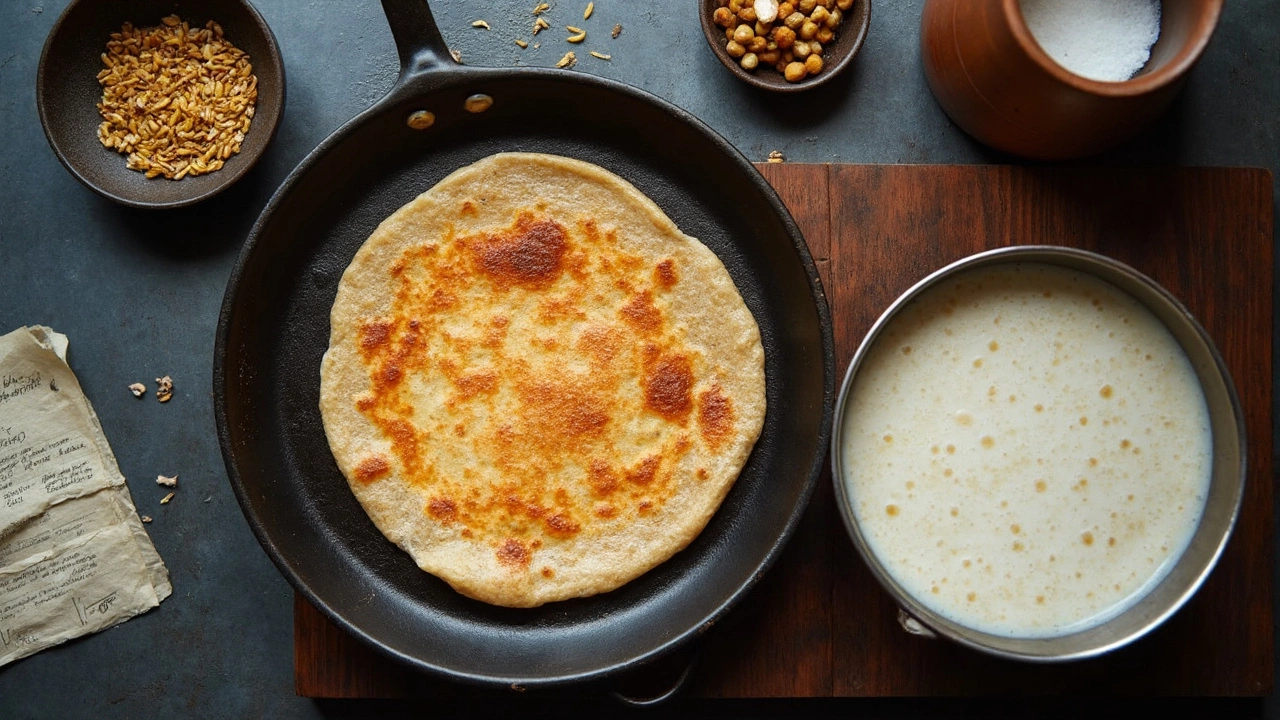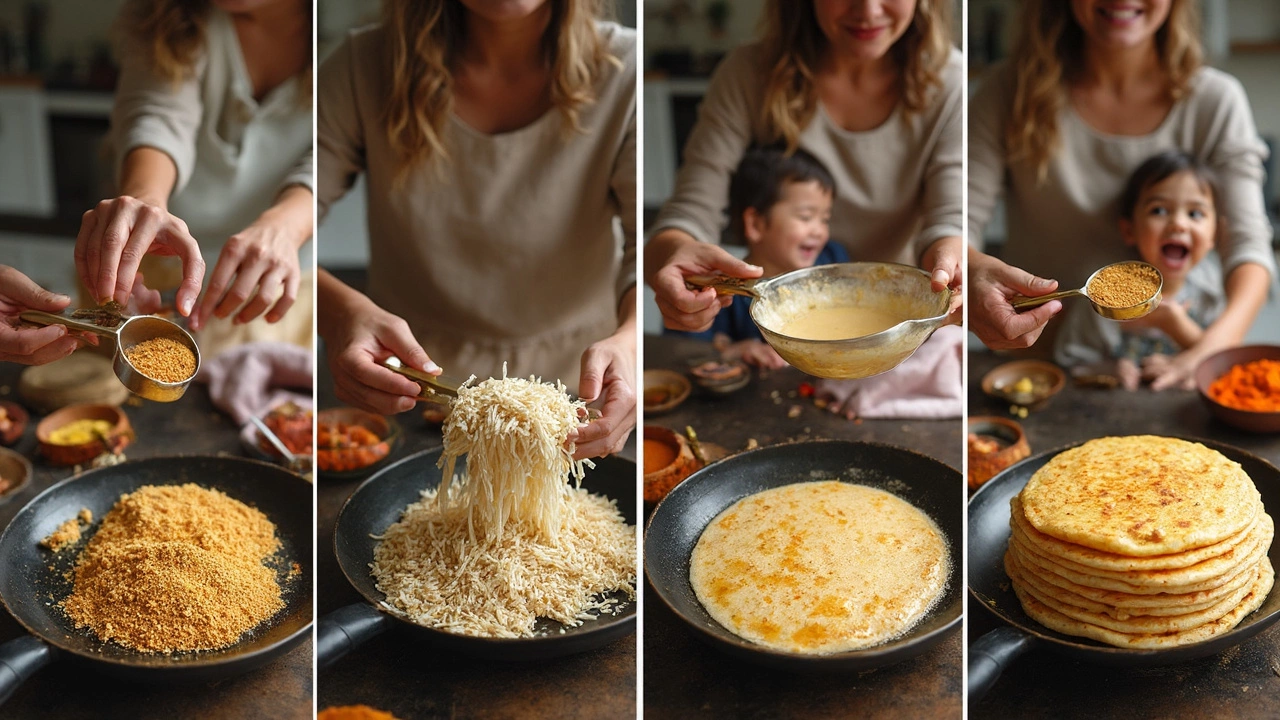Did you ever wonder why every dosa batter recipe calls for a tiny handful of fenugreek seeds? It isn’t just for show, or because your grandmother told you so. Fenugreek (methi) is like that behind-the-scenes team member who makes everything work—especially when you want dosas that are crisp, golden, and a little tangy.
Most people just toss fenugreek seeds in with the rice and dal without thinking about it. Here’s the thing: fenugreek is the reason your batter ferments better and faster. It actually helps make the whole thing lighter and fluffier without you needing to add baking soda or other cheats.
If you ever left out fenugreek, there’s a good chance your dosas came out too dense or tasted flat. So next time, don’t skip it—you’ll see a real difference in how your dosas look and taste.
- The Secret Science of Fenugreek in Dosa Batter
- Impact on Taste and Texture
- Fermentation Boosters: Why It Matters
- Tips for Perfectly Using Fenugreek
- Troubleshooting: When Dosas Go Wrong
The Secret Science of Fenugreek in Dosa Batter
People often ask, why bother adding those tiny fenugreek seeds to dosa batter? Is it really science, or just an old habit? Well, it’s definitely science. The most important job fenugreek does in dosa batter is help fermentation. These seeds are loaded with natural compounds that kickstart and speed up the whole fermentation process. So instead of waiting ages for your batter to bubble up, a small amount of fenugreek gets things moving much quicker.
Here’s what’s happening behind the scenes: When you soak fenugreek with rice and dal, it releases a slimy substance called mucilage. This goo might look odd, but it makes the batter thick and helps trap air when the batter ferments. More air = more holes = crispier dosas.
And it gets better—fenugreek is packed with enzymes and good bacteria that actually help break down the dal and rice, producing more lactic acid. Why does this matter? Because it’s lactic acid that gives dosa their classic tangy flavor and soft texture inside.
Check out this quick breakdown of what fenugreek does in dosa batter:
- Acts as a natural fermenting agent—no need for store-bought yeast or soda
- Makes batter naturally thick so the dosa spreads just right
- Boosts the tang and soft bite every good dosa needs
- Encourages more bubbles, which means crispier, lighter dosas
And there’s even a bonus for health nerds: fenugreek brings fiber and a bit of protein to your dosa. It’s like adding nutrition without any effort.
So next time you’re prepping your dosa batter, remember, that teaspoon of fenugreek is your secret weapon. Leave it out, and you’ll notice the difference in both the batter and the final dosa. Yes, even Zoya sniffs around extra when there’s fenugreek in the air—now you know why!
Impact on Taste and Texture
Add a pinch of fenugreek to your dosa batter, and you’ll instantly get why it’s such a must. First off, fenugreek's natural compounds give your dosas that classic, mild tang many people crave. Without it, you’re left with a flat flavor that’s just not the same, even if you nail the rest of the dosa recipe.
Texture-wise, fenugreek is kind of magical. It acts almost like a natural emulsifier. When you blend the soaked seeds into the batter, they help break down rice and urad dal, making your batter smoother. This means your dosas spread easier on the pan and cook up with tiny, crunchy holes–just like at your go-to South Indian restaurant.
If you’ve ever had dosas that felt dry or cracked, lack of fenugreek could be the culprit. Fenugreek pulls in a little extra moisture, keeping your dosas soft inside but still giving you the golden edge and crisp bite outside.
- Taste: Adds gentle bitterness and that essential hint of earthiness.
- Color: Encourages a lovely golden-brown hue as the sugars in fenugreek caramelize.
- Texture: Keeps dosas from being too dense and makes them fluffier.
Not convinced? Here’s how dosas with and without fenugreek stack up:
| Aspect | With Fenugreek | Without Fenugreek |
|---|---|---|
| Flavor | Tangy, balanced | Bland, sometimes dry |
| Texture | Crispy edges, soft centers | Can be rubbery or dense |
| Color | Golden brown | Pale, uneven |
So, that little handful of fenugreek? It’s not just tradition—it's your cheat code to dosas everyone will remember.

Fermentation Boosters: Why It Matters
Fermentation is the backbone of a good dosa. Without solid fermentation, your batter just won’t bubble up, and you’ll end up with flat, gummy pancakes. Here’s where fenugreek steps in. These seeds act like a natural helper, making sure the wild yeasts and good bacteria work faster and harder in your dosa batter.
So, why does this matter so much? Fenugreek contains compounds that actually “feed” the friendly microbes. This gets the batter nice and sour (in a good way) while making it airy and light. You’ll often notice that when fenugreek is missing, the batter just doesn’t rise the same way, even if you give it extra hours to rest.
If you live somewhere cold or your kitchen isn’t too warm, fenugreek becomes a lifesaver. People in South India always add a small amount—about 1 to 2 teaspoons for every 2 cups of rice—to keep the fermentation on track, even during monsoon or winter months. This trick isn’t just old-school wisdom; it’s serious science. Studies have actually found better microbial growth with fenugreek in the mix compared to just rice and dal alone. Here’s a quick look:
| Batter Type | Rise Time (Room Temp) | Volume Increase |
|---|---|---|
| With Fenugreek | 8-12 hrs | Up to 2X |
| Without Fenugreek | 12-18 hrs | 1.3X - 1.5X |
So, a tiny scoop helps you cut down waiting time and get those mouthwatering dosas ready for breakfast (or dinner) faster. It also means your dosa recipe turns out consistent, no matter where or when you’re cooking. If your kitchen is freezing or you’re in a rush, try a pinch more fenugreek. It won’t overpower the taste, but it’ll definitely give your batter that happy, bubbly boost.
Tips for Perfectly Using Fenugreek
Getting fenugreek right in your dosa batter can make or break your results, so let’s nail down the best ways to use it. First up—quantity is key. For most basic dosa batters (using about 2 cups rice and ¾ cup urad dal), a teaspoon of fenugreek seeds is enough. Too much, and your dosa will taste bitter. Too little, and you’ll lose the magic fermentation boost.
Don’t skip soaking. Always soak fenugreek seeds along with the urad dal for at least 4-6 hours. This softens the seeds, making them easy to grind and helps them blend smoothly with the dal. If you’re using a mixer or wet grinder, fenugreek acts like a natural thickener, making your batter light and high in volume.
- Stick to whole seeds—powdered fenugreek doesn’t produce the same effect.
- Rinse the seeds well before soaking to avoid any bitterness.
- If you live somewhere cool, try using slightly more fenugreek. It helps kickstart the fermentation even in colder climates.
If you’re worried about having a bitter aftertaste, don’t. If you stay close to the teaspoon mark for each batch, the dominant flavors remain that classic tangy dosa taste.
Want your dosas to be extra crispy? A small pinch of extra fenugreek can add that crunch. But it’s a balancing act, so keep it under control.
| Ingredient | Standard Quantity |
|---|---|
| Rice | 2 cups |
| Urad Dal | 3/4 cup |
| Fenugreek Seeds | 1 teaspoon |
Try this once, and you’ll notice fewer sticky dosas, better rise, and a consistent golden crisp. All thanks to that humble little seed—fenugreek.

Troubleshooting: When Dosas Go Wrong
Let’s be real—getting dosa batter right feels like a mini battle some days. You followed the recipe, but your dosas are sticking, too sour, super thick, or not even close to crispy? It happens to everyone, so let’s fix it, one problem at a time.
- Dosas stick to the pan? Your batter could be too thin, or your pan isn’t hot enough. Sometimes, if you skip fenugreek, the batter doesn’t ferment well and turns super sticky. Add a few more soaked fenugreek seeds next time and make sure your tawa is sizzling before you pour the batter.
- Not fermenting properly? If the batter barely rises, check your fenugreek—are you using at least ¼ teaspoon per cup of rice? Fenugreek really boosts fermentation. In winter, stick your batter in the oven with just the light on, or keep it close to something warm.
- Dosas came out too sour? Over-fermentation can do that. High amounts of fenugreek or extra warm temperatures speed things up, so don’t let your batter sit too long—8 to 12 hours usually does it in most Indian homes.
- Dense, chewy texture? That’s probably a fermentation problem, and not enough fenugreek could be the culprit. Use fresh seeds, soak them with the dal, and blend well for better results.
- No golden, crispy edges? Sometimes it’s oil, but a batter low on fenugreek can mess with the classic dosa texture. Fenugreek releases natural compounds that help browning and crispiness. Don’t skimp on it.
Check out this simple table to troubleshoot your next batch:
| Problem | Likely Reason | Quick Fix |
|---|---|---|
| Sticking | Batter too thin or poorly fermented | Increase fenugreek, heat pan more |
| No Rise | Lack of fenugreek, cold room | Add more fenugreek, keep batter warm |
| Too Sour | Over-fermented, excess fenugreek | Ferment less time |
| Not Crispy | Low fenugreek, thick batter | Add fenugreek, thin batter slightly |
Don’t get discouraged if your dosa recipe flops sometimes! A little tweak with fenugreek usually covers most problems. The more you experiment with your dosa batter, the better you’ll get. Even my dog Zoya has seen several flopped dosas turn into her favorite crunchy treats—so nothing has to go to waste!
